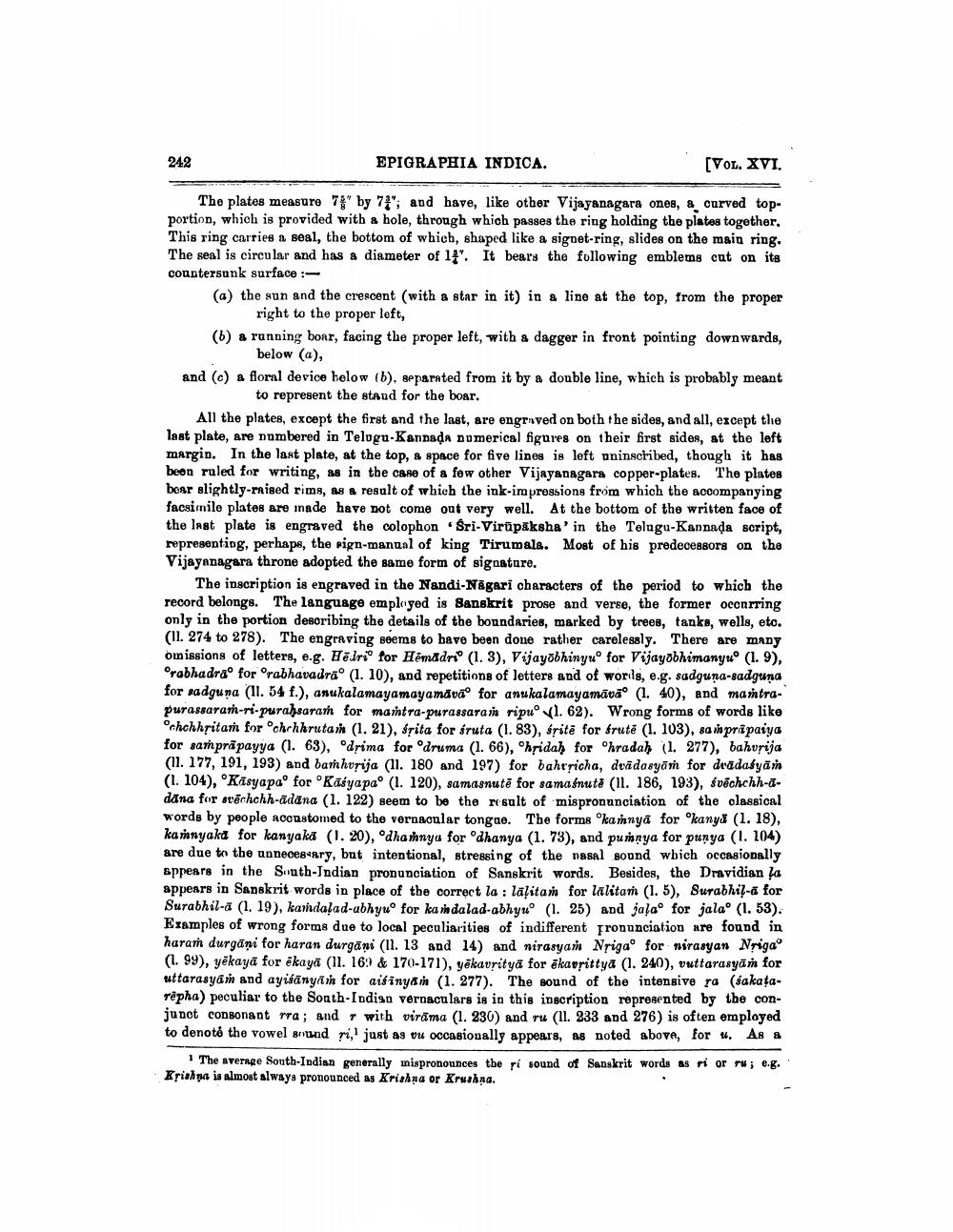________________
242
EPIGRAPHIA INDICA.
[VOL. XVI.
The plates measure 7" by 72"; and have, like other Vijayanagara ones, a curved topportion, which is provided with a hole, through which passes the ring holding the plates together. This ring carries a seal, the bottom of which, shaped like a signet-ring, slides on the main ring. The seal is circular and has a diameter of 14". It bears the following emblems cut on its countersunk surface :
(a) the sun and the crescent (with a star in it) in a line at the top, from the proper right to the proper left,
(b) a running boar, facing the proper left, with a dagger in front pointing downwards, below (a),
and (c) a floral device below (b), separated from it by a double line, which is probably meant to represent the stand for the boar.
All the plates, except the first and the last, are engraved on both the sides, and all, except the last plate, are numbered in Telugu-Kannada numerical figures on their first sides, at the left margin. In the last plate, at the top, a space for five lines is left uninscribed, though it has been ruled for writing, as in the case of a few other Vijayanagara copper-plates. The plates bear slightly-raised rims, as a result of which the ink-impressions from which the accompanying facsimile plates are made have not come out very well. At the bottom of the written face of the last plate is engraved the colophon 'Sri-Virupaksha' in the Telugu-Kannaḍa script, representing, perhaps, the sign-manual of king Tirumala. Most of his predecessors on the Vijayanagara throne adopted the same form of signature.
The inscription is engraved in the Nandi-Nagari characters of the period to which the record belongs. The language employed is Sanskrit prose and verse, the former occurring only in the portion describing the details of the boundaries, marked by trees, tanks, wells, etc. (11. 274 to 278). The engraving seems to have been done rather carelessly. There are many omissions of letters, e.g. Her for Hemadri (1. 3), Vijayōbhinyu for Vijayabhimanyu (1.9), rabhadra for rabhavadra° (1. 10), and repetitions of letters and of words, e.g. sadguna-sadguna for sadguna (11. 54 f.), anukalamayamayamava for anukalamayamāvā (1. 40), and mamtrapurassaram-ri-purahsaram for mantra-purassaram ripu 1. 62). Wrong forms of words like chchhritam for "chchhrutam (1. 21), śrita for śruta (1.83), śrite for śrute (1. 103), samprapaiya for samprapayya (1. 63), drima for druma (1. 66), 'hridah for "hradah (1. 277), bahvrija (11. 177, 191, 193) and bamhurija (11. 180 and 197) for bahrṛicha, dvadasyam for dradasyam (1. 104), Kasyapa for °Kasyapa" (1. 120), samasnute for samasnute (11. 186, 193), svechchh-adana for svechchh-ädana (1. 122) seem to be the result of mispronunciation of the classical words by people accustomed to the vernacular tongue. The forms kamnya for kanya (1. 18), kamnyaka for kanyaka (1. 20), °dhamnya for dhanya (1. 73), and pumnya for punya (1. 104) are due to the unnecessary, but intentional, stressing of the nasal sound which occasionally appears in the South-Indian pronunciation of Sanskrit words. Besides, the Dravidian la appears in Sanskrit words in place of the correct la: lälitam for lälitam (1. 5), Surabhil-a for Surabhil-a (1. 19), kamdalad-abhyu° for kam dalad-abhyu (1. 25) and jala° for jala° (1. 53). Examples of wrong forms due to local peculiarities of indifferent pronunciation are found in haram durgani for haran durgani (11. 13 and 14) and nirasyam Nriga for nirasyan Nriga (1. 99), yekaya for ēkaya (11. 169 & 170-171), yekavṛityä for ekavṛittya (1. 240), vuttarasyam for uttarasyam and ayisanyam for aisinyam (1. 277). The sound of the intensive ra (sakatarepha) peculiar to the South-Indian vernaculars is in this inscription represented by the conjunct consonant rra; and r with virama (1. 230) and ru (11. 233 and 276) is often employed to denote the vowel sound ri, just as vu occasionally appears, as noted above, for u. As a
1 The average South-Indian generally mispronounces the ri sound of Sanskrit words as ri or ru; e.g. Krishna is almost always pronounced as Krishna or Krushna.




